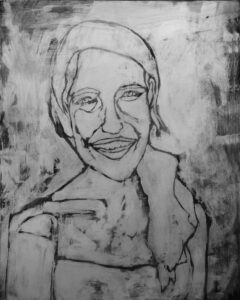From Projects to Portfolios: Rethinking Your Art Lessons for Portfolios
During my first few years of teaching I taught the same two classes over and over. I taught mostly freshman. I still have a soft spot for freshman but I was pretty excited when I took a new job and had the opportunity to teach juniors in a class called Portfolio Preparation. While teaching freshman I never, not once, worried about what they would put in their portfolio for college. It was a skill building class and if they were serious about art the expectation was the upper level art classes would provide more than enough opportunities.
Well, those were the good ‘ol days, my friend. The days when students had room in their schedule to take four years of art is largely over. I am sure it varies from state to state and school to school but I think students are more stretched with requirements. The effect this had on me as an art teacher and, eventually, as a department chair was profound. I needed to rethink my curriculum. Every assignment needed to count, and be versatile. I still needed build skills but I made some shifts in my assignment that allowed for the possibility that every assignment could be portfolio worthy.
Here is what I would suggest you think about with your assignments:


 Observation
Observation
Students need to show direct observation. This could be a portrait, the human figure, landscape, animals, a still life or more. Not working from a photograph is key. A photograph flattens and distorts the subject matter. It does not give you compositional control and translates values, all skills that the student needs to develop. Do any of you watch the British Baking Show? I liken observational drawing to the technical challenges. For my curriculum, old favorites like grid drawings were removed in favor of life drawing.
My students were surprised when a college representative told them they could spot a piece created from a photograph most of the time. She went through students’ portfolios and proved her point, guessing correctly every time. It made me laugh, because I knew it was obvious but the students had no idea that it was that obvious to the trained eye.
Keep everything
Encourage students to save everything. Emphasize process and product. The blind contour drawing they thought was hysterical might be a seriously good portfolio piece. Or the half finished drawing might be revisited and developed.
I can not tell you how many times I sat down with a student to help them decide what to include in their portfolio. When they had everything out, I would ask them what was left in their portfolio. Oh, the hidden gems I found! Students play it safe all the time. Those leftovers were often things they took risks on. Or sometimes they were studies, sketches, or unfinished work. That doesn’t mean they aren’t portfolio worthy. I had a student use a piece that started off as a doodle on lined paper once.
On this topic, don’t forget the sketchbooks. Sketchbook work is a great place to find potential portfolio pieces. Don’t neglect sketchbooks in your classroom. Use them for bell ringers, thumbnail sketches, for early finishers, process work and more. Use it in the classroom, use it for homework. Create a sketchbook habit.
Student Voice and originality
It is not enough to be a good draftsman. In art curriculum teachers should encourage a personal style and empower a student to leverage art’s ability to communicate. The Scholastic Art Awards defines originality as, “Work that breaks from convention, blurs the boundaries between genres, and challenges notions of how a particular concept or emotion can be expressed.” Assignments that stretch students’ imagination, make a statement, and solve a problem are all important to include in your curriculum. Teach compositions, particularly unexpected perspectives. Prompt students to think about identity through self portraiture. Encourage students to draw on personal experiences and interest in a particular subject or medium whenever possible.
In encouraging originality, you can use that to strike down the common place, the cliché and copyrighted. No photographs of movie stars, no peace symbols, no Pokemon, etc.
Size matters
Make your students work larger. I would say between 12×18 and 18×24. I know what you’re thinking. That’s hard to store, possibly expensive, and there will be some waste involved. Students may be intimidated. But working large allows them to loosen up. Students can really embrace drawing using the entire arm, not just their hand. It also means they will really need to display some perseverance.
And how many works make a portfolio? Schools are different but the broad range is 10-20 pieces. I usually look for 3-4 projects a semester. If they take three years of art that is 9-12 pieces of art. By summer before senior year, I usually know who is making a portfolio and have given them summer work and options for summer art programs. They should both enjoy making art on their own and make time for it.
Diversity
Projects should cover a wider ground of media, styles, techniques and topics.
Talk
Encourage students to talk about art. Don’t make their first time talking about the art making process be at a portfolio day or in their college interview. Ask students how they came up with an idea. Ask them to describe their artistic process. This can be in written reflections, project critiques, and classroom discussions. Give students the vocabulary they need to speak articulately about art and art making. The elements of art and principles of design are a good place to start.
Preparing for good portfolios should walk hand in hand with creating good art curriculum and good artists.






